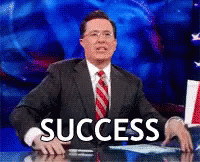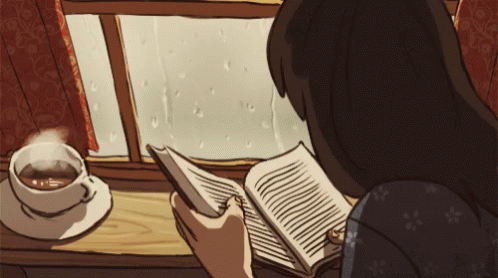Sunday, March 22, 9:42 p.m.:
Well, it's the end of another readathon. I finished reading four books and started two others over the course of this readathon. I must have finished somewhere between 300 and 500 pages in total, though I did not keep a specific count. Not all of the books were that great (I'm looking at you
Ulysses), but it is always a pleasure to get something finished. I hope to do another readathon in the near future, but we will see how things turn out. Thanks to everyone who has read this live blog and a special thanks to the bloggers at
24in48.com for putting this on. See you all next time!
Sunday, March 22, 8:45 p.m.:
Well, I finished A Long Walk to Water and I thought it was a very good middle grade read about the Sudanese Civil War, the plight of refugees, and the good things that they can do if given a chance to immigrate and prosper in America. I gave it 5 out of 5 and I would recommend it, but just use some parental caution if giving it to younger readers. Some people die in pretty awful ways in the book. While I am going to start The Hound of the Baskervilles by Arthur Conan Doyle, unfortunately I won't be able to finish it during this readathon seeing as it is technically suppose to end at 9 p.m. PST (12 a.m. EST). But, I am looking forward to ending this thing with Mr. Sherlock Holmes
Sunday, March 22, 4:57 p.m.:
And another book is finished! I just read the last page of All Systems Red: The Murderbot Diaries #1 by Martha Wells. This was a pretty good book, but, like a lot of novellas, things moved very quickly, particularly at the end, and I would've liked a lot more details. So, 3.5 stars for this one. An enjoyable, lite read and I might want to read more of the series in the future. Now, on to A Long Walk to Water...
Sunday, March 22, 3:22 p.m.:
It appears the big brunch I had is affecting me a little more than I expected it to. I started dozing off a little in the middle of my chapter. But, I got the first chapter of Ocean of Milk, Ocean of Blood finished. On now to All Systems Red...
Sunday, March 22, 2:00 p.m.:
Saturday, March 21, 10:19 p.m.:
I was able to get a little more of All Systems Red completed and I am now halfway done with it. But with dinner and Skyping with my Bible study friends, the time went by more quickly than I had anticipated. One thing I promised myself during this readathon is that I would get a good night's sleep and that is exactly what I am going to do right now. So, good night everyone. I will see you sometime tomorrow for day 2.
Saturday, March 21, 5:57 p.m.:
Even though I am also taking care of laundry right now, I am still checking off the boxes of books I wanted to finish reading this weekend. I just finished reading A Long Petal of the Sea by Isabel Allende, a good historical fiction novel about a pair of refugees fleeing the Spanish Civil War and putting down roots in Chile. It's good, but rather short in comparison to other historical fiction novels in the same genre. Still, it might be a good one to start with for those who have wanted to jump into the genre but have been intimidated by the size of some of the best known ones.
I also discovered that All Systems Red by Martha Wells is actually a novella, not a novel like I first thought. Though I wasn't planning on it, I think I am going to try to finish it this weekend as well. In fact, that is what I will be picking up right now...
Saturday, March 21, 3:39 p.m.:
It's over! I've finally finished reading this long nightmare of a book Ulysses by James Joyce. I've been working on this book for over a month now and every page was a confusing bore. No plot, ever changing style, etc. This may be an interesting book for English Lit. majors, but it's a completely confusing mess to me. I give it only 1 star. Now, on to finishing A Long Petal of the Sea...
Saturday, March 21, 2:10 p.m.:
I just finished the first chapter of All Systems Red. Wow! This book is going to be a much quicker read than I thought. Still, I'm going to circle back to Ulysses and A Long Petal of the Sea and finish those books today.
Saturday, March 21, 1:45 p.m.:
It turns out that my online meeting was much shorter than I thought it was going to be. So, I ate a nutritious lunch and I am now back on the reading clock. Going to read my first chapter of All Systems Red by Martha Wells. Oh, and I have to do laundry at the same time.
Saturday, March 21, 12:28 p.m.:
I just finished reading the introduction to Ocean of Milk, Ocean of Blood by Matthew King. It's about the life and legacy of an influential Mongolian Buddhist monk at the beginning of the 20th century. Phew! It looks like this is going to be another tough read. But now I need to eat some lunch and go to a virtual meeting. I should be back to reading around 3 p.m., if not sooner.
Saturday, March 21, 11:12 a.m.:
Saturday, March 21, 9:50 a.m.:
Just finished a little bit of my Ulysses reading and I am now just 34 pages away from finishing it. I've been working on this god-awful "classic" for over a month now and I will be glad to be done with it once and for all and move on to something better.
Hour Zero:
It has been several months since
I last did a readathon and live blogged it and with all the craziness going on in the world right now, I think it is time to knock another one of these out of the park. Fortunately, the bloggers over at
24in48.com created a Social Distancing Readathon for this weekend. And, unlike a traditional readathon, this one takes place over the course of two days. So, instead of exhausting myself trying to get 24 straight hours of reading done, I am going to try to space it out over the next two days. In fact, I plan on taking this one a little easier than the last one, so this will be the main place people can come to for my live blogging. I am going to get things started with a little
Ulysses by James Joyce and
A Long Petal of the Sea by Isabel Allende and go from there. Wish me luck!





























